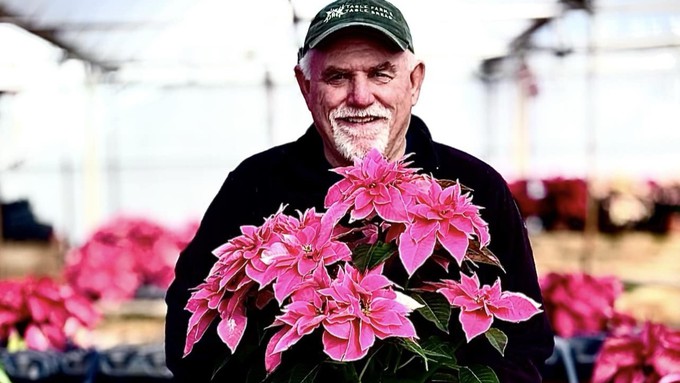
No matter the color, how to help your Christmas plants look their best

Greg Gayton of Green Acres Nursery & Supply holds the I Love You Pink poinsettia, one of the newest (and popular) hybrid holiday plants. Courtesy Green Acres Nursery and Supply
From florists to nurseries to supermarkets, hybrid poinsettias are everywhere, packing plenty of wow into their colorful bracts.
And those poinsettias are flying off the plant stands. Greg Gayton, garden guru at Green Acres Nursery & Supply, reports that they were nearly sold out this week, despite growing thousands of popular plants.
Green Acres’ poinsettias are locally grown, and that helps them adapt to Sacramento homes and gardens. When Green Acres purchased Eisley’s Nursery in Auburn, it also took over Eisley’s vast plant propagation operation. Over the decades, Eisley’s has grown millions of poinsettias for local buyers.
Particularly popular this season: Bright pink poinsettias. Among the varieties that Gayton likes are Pretty Polly (an eye-popping magenta) and I Love You Pink.
Poinsettias also come in yellow, gold, white, variegated and of course red in a wide range of bract shapes such as curly, skinny and extra wide. The bracts are what most people think of as petals.
The key to selecting a fresh poinsettia that will last until New Year’s is focusing on what’s at that center of those bracts – the small yellow true flowers or cyathia. They should look fresh and not turning brown. Any poinsettias missing those little yellow flowers are past their prime.
The bracts should appear fresh, too, but also notice the dark green leaves lower on the stem. Make sure the foliage looks healthy and not drooping or falling off.
According to experts, the most common problem with poinsettias is overwatering. People kill them with kindness. Take off the foil wrapper or punch holes in the bottom (and place a saucer underneath). Poinsettias – semi-tropical members of the Euphorbia family – demand good drainage and prefer soil on the dry side of moist. Give the plant a drink once a week (or as needed) and don’t let the poinsettia stand in water. The best way to know if your poinsettia needs watering? Pick it up. If it seems light, it’s time to water.
Cold kills poinsettias; they can’t take prolonged temperatures under 50 degrees. So, if decorating with poinsettias outdoors, bring them inside or protect them at night. They prefer bright light and temperatures between 65 and 70 degrees (just like most people do).
Contrary to popular belief, poinsettias are not poisonous – to people, dogs or cats. Studies at Ohio State and Washington State universities debunked myths about poinsettia toxicity. A 50-pound child would need to eat more than 500 poinsettia bracts to reach a toxic level.
That doesn’t mean poinsettias are edible. Their milky sap will cause mouth and skin irritation (and keep any person or animal from munching them).
For more on poinsettia care: https://ucanr.edu/sites/urbanhort/files/80155.pdf
Comments
0 comments have been posted.Sacramento Digs Gardening to your inbox.
Food in My Back Yard Series
May 6: Maintain soil moisture with mulch for garden success
April 29: What's (already) wrong with my tomato plants?
April 22: Should you stock up on fertilizer? (Yes!)
April 15: Grow culinary herbs in containers
April 8: When to plant summer vegetables
April 1: Don't be fooled by these garden myths
March 25: Fertilizer tips: How to 'feed' your vegetables for healthy growth
March 18: Time to give vegetable seedlings some more space
March 11: Ways to win the fight against weeds
March 4: Potatoes from the garden
Feb. 25: Plant a fruit tree now -- for later
Feb. 18: How to squeeze more food into less space
Feb. 11: When to plant? Consider staggering your transplants
Feb. 4: Starting in seed starting
Sites We Like
Garden Checklist for week of May 11
Make the most of the lower temperatures early in the week. We’ll be back in the 80s by Thursday.
* Plant, plant, plant! It’s prime planting season in the Sacramento area. Time to set out those tomato transplants along with peppers and eggplants. Pinch off any flowers on new transplants to make them concentrate on establishing roots instead of setting premature fruit.
* Direct-seed melons, cucumbers, summer squash, corn, radishes, pumpkins and annual herbs such as basil.
* Harvest cabbage, lettuce, peas and green onions.
* In the flower garden, direct-seed sunflowers, cosmos, salvia, zinnias, marigolds, celosia and asters. (You also can transplant seedlings for many of the same flowers.)
* Plant dahlia tubers.
* Transplant petunias, marigolds and perennial flowers such as astilbe, columbine, coneflowers, coreopsis, dahlias, rudbeckia and verbena.
* Keep an eye out for slugs, snails, earwigs and aphids that want to dine on tender new growth.
* Feed summer bloomers with a balanced fertilizer.
* For continued bloom, cut off spent flowers on roses as well as other flowering plants.
* Add mulch to the garden to maintain moisture. Mulch also cuts down on weeds. But don’t let it mound around the stems or trunks of trees or shrubs. Leave about a 6-inch-to-1-foot circle to avoid crown rot or other problems.
* Remember to weed! Pull those nasties before they set seed.
* Water early in the day and keep seedlings evenly moist.